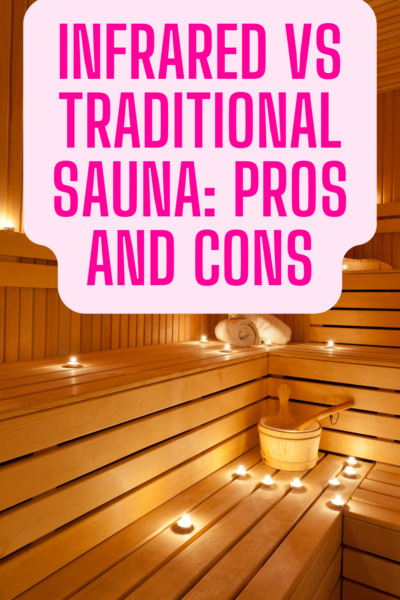Introduction:
An infrared vs traditional sauna? Which one is the best choice for your health and wellness needs? Saunas have long been a popular wellness practice, known for their relaxation and detoxification benefits. With the rise of infrared saunas as an alternative to traditional saunas, many are curious about the differences between the two. Both offer unique benefits, but they also come with their own sets of pros and cons. Let’s explore the key distinctions to help you decide which type of sauna might be best for your wellness routine.
Traditional Sauna: The Classic Experience
Pros:
- Intense Heat: Traditional saunas use a heat source, such as a wood stove, electric heater, or gas stove, to warm the air to high temperatures, typically between 150°F and 195°F (65°C to 90°C). This intense heat is great for those who enjoy a robust sweating experience.
- Deep Relaxation: The high heat in a traditional sauna can help relax muscles and soothe aches and pains. The heat also induces a deep, meditative state, making it ideal for stress relief.
- Cultural Tradition: Traditional saunas have a rich history, especially in cultures like those in Finland, where sauna use is an integral part of daily life. The experience is as much about cultural tradition and ritual as it is about health.
- Social Experience: Traditional saunas are often larger and can accommodate more people, making them a social activity. The shared experience can enhance feelings of community and connection. You can also often find traditional saunas at gyms making them easier to access without having to pay for more than just a standard gym membership.
Cons:
- High Temperatures: The intense heat of a traditional sauna can be overwhelming, especially for those with certain health conditions or those who are not accustomed to high temperatures. It can also lead to dehydration if proper care is not taken.
- Longer Heating Time: It takes time for a traditional sauna to heat up, often around 30 to 45 minutes, which can be inconvenient if you’re looking for a quick session.
- Energy Consumption: Traditional saunas require more energy to maintain high temperatures, which can lead to higher electricity bills or, in the case of wood-burning saunas, a need for a steady supply of firewood.
- Space Requirements: Traditional saunas are typically larger and require more space, which may not be practical for everyone.
Infrared Sauna: The Modern Alternative
Pros:
- Lower Temperatures: Infrared saunas use infrared heaters to emit light that is absorbed by the skin, directly heating the body without raising the temperature of the surrounding air as much. The temperature in an infrared sauna usually ranges between 120°F and 140°F (48°C to 60°C), making it more tolerable for those sensitive to heat.
- Quicker Heat-Up Time: Infrared saunas heat up much faster than traditional saunas, often in about 10 to 15 minutes, allowing for a quicker and more convenient sauna session.
- Deep Penetration: Infrared heat penetrates deeper into the body’s tissues, which can enhance detoxification, improve circulation, and promote healing. Some studies suggest that infrared saunas may help with conditions like chronic pain, arthritis, and high blood pressure. They also have infrared lights which offer a different kind of healing experience.
- Energy Efficiency: Infrared saunas generally use less energy than traditional saunas, making them a more environmentally friendly and cost-effective option.
- Compact Design: Infrared saunas are often smaller and can be installed in tighter spaces, making them accessible for home use even in smaller areas.
Cons:
- Less Intense Heat: While the lower temperatures can be a pro for some, those who enjoy the intense heat and heavy sweating of a traditional sauna might find the infrared experience less satisfying.
- Different Experience: The lack of steam and the quieter nature of an infrared sauna can make the experience feel less communal or less traditional, which may not appeal to everyone.
- Potential Skin Irritation: Some users report skin irritation from the infrared light, though this is relatively rare. It’s important to monitor your skin’s response, especially during the first few sessions.
- Less Research: While infrared saunas are becoming increasingly popular, there is less long-term research on their effects compared to traditional saunas. While initial studies are promising, more research is needed to fully understand the long-term health benefits and risks.
Which Sauna Is Right for You?
The choice between an infrared and a traditional sauna largely depends on your personal preferences and wellness goals. If you enjoy intense heat and the ritualistic nature of sauna use, a traditional sauna might be the best fit. However, if you’re looking for a more comfortable experience with added benefits like deep tissue penetration and energy efficiency, an infrared sauna could be the better option. I personally use both, although I have a personal infrared sauna in my bedroom and there is a traditional sauna at the gym where I go swimming.
Regardless of which type you choose, saunas can be a valuable addition to your self-care routine, offering a range of physical and mental health benefits. As with any wellness practice, it’s important to listen to your body and consult with a healthcare professional, especially if you have any underlying health conditions.

Did this help you? If so, I would greatly appreciate a share on Facebook, twitter, linkedin, or pinterest.
My Favorite Products (Affiliate links- if you make a purchase I may earn a small commission)
Thrive Market - healthy gluten free, sugar free and speciality online food and household products
Silk and Sonder Monthly Journals and Planners
My Portable Infrared Sauna
Self Care Journal
Martie discounted food
Olipop - healthy soda with probiotics and prebiotics
Digestion Kit
Stress Oils








